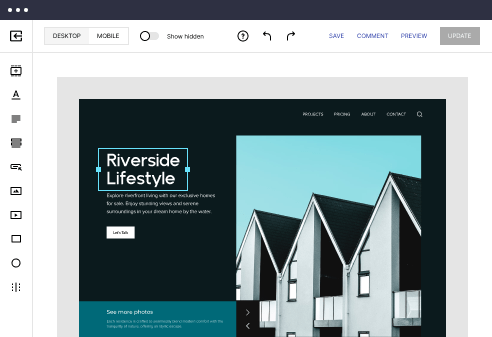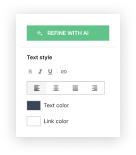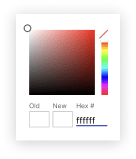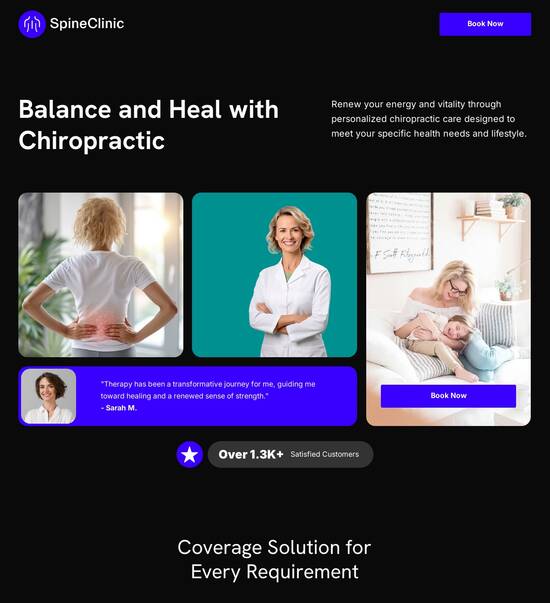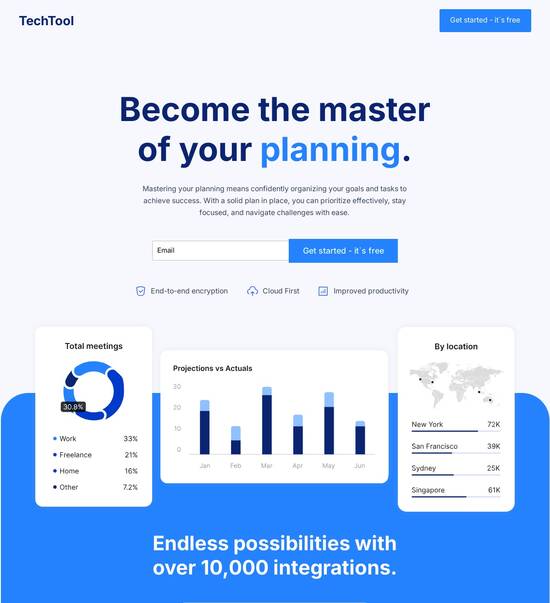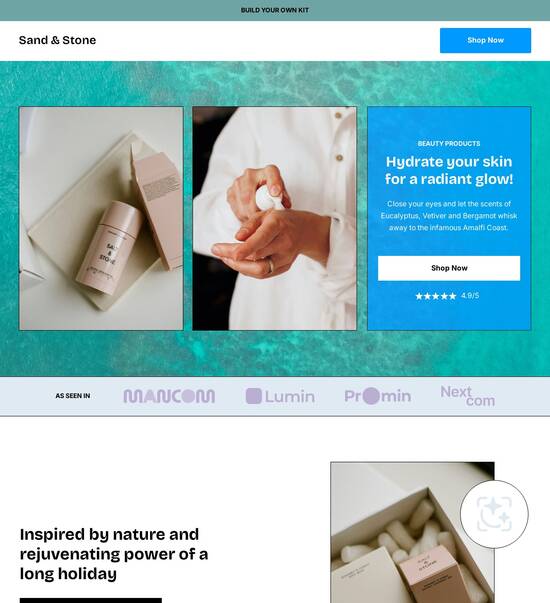
Sales page template for React.js developers
Explore Similar TemplatesAbout template
Master your online marketing with this builder for sales page template for React.js developers. Try more tools to create an immaculate landing page.
Recommended templates
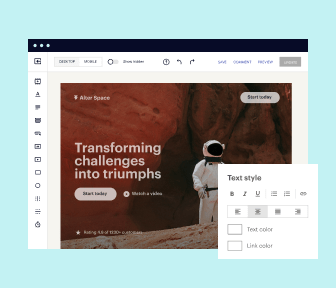
Easy to build without coding
With the intuitive drag-and-drop builder, anyone on your team can create high-converting pages without any knowledge of code or design. Make enhancements to your landing page with custom widgets using Javascript, HTML/CSS, or third-party scripts.
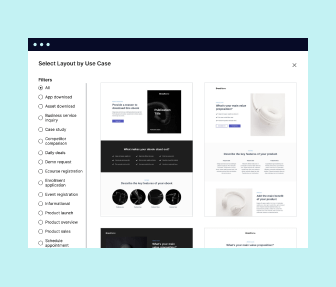
Multiple layouts for any industry and goal
Select from 500+ landing page layouts built to boost conversions across industry-specific scenarios. Customize them by adjusting fonts, adding images, and generating on-brand content with the AI assistant. Quickly scale with Instablocks® and Global Blocks that you can save, reuse, and update globally.

Loads fast and looks polished on any device
Every template is responsive, which means they present professionally on any device and load blazingly fast with our Thor Render Engine. You can also power them up with Google AMP technology to deliver an unparalleled mobile experience and drive higher conversions.
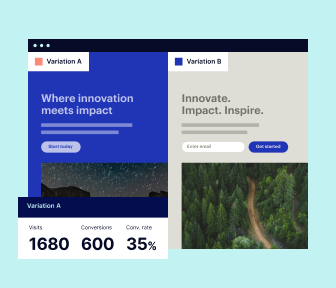
Robust analytics & experimentation
Get real-time updates and reporting across all your devices, showing the number of visitors, conversions, cost-per-visitor, and cost-per-lead. Launch AI-powered experiments, run A/B tests, and use heatmaps to analyze user behavior, then optimize your landing page to maximize conversions.
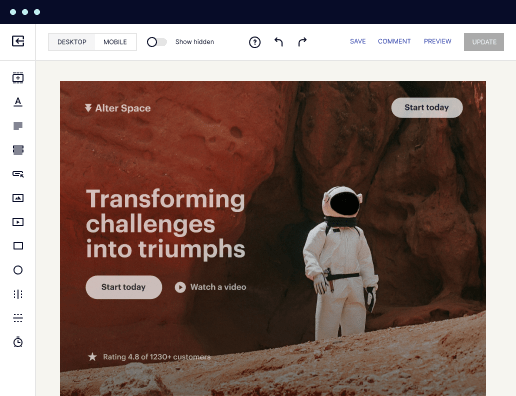
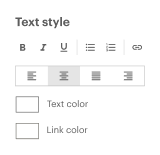
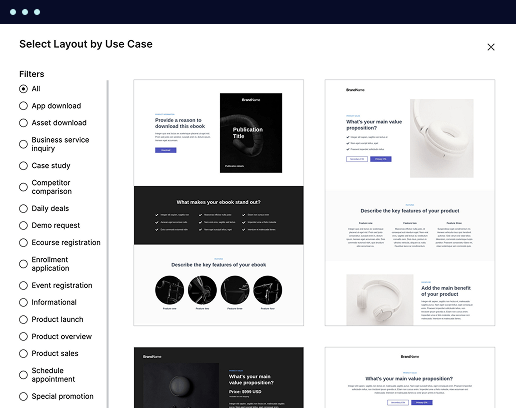

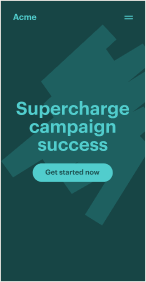
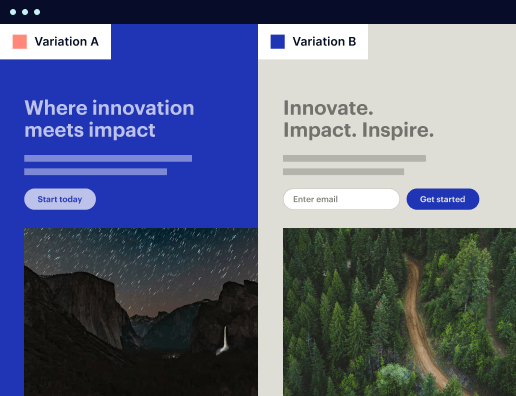
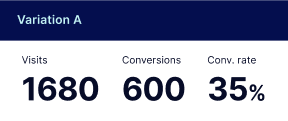
Easy to build without coding
With the intuitive drag-and-drop builder, anyone on your team can create high-converting pages without any knowledge of code or design. Make enhancements to your landing page with custom widgets using Javascript, HTML/CSS, or third-party scripts.
Multiple layouts for any industry and goal
Select from 500+ landing page layouts built to boost conversions across industry-specific scenarios. Customize them by adjusting fonts, adding images, and generating on-brand content with the AI assistant. Quickly scale with Instablocks® and Global Blocks that you can save, reuse, and update globally.
Loads fast and looks polished on any device
Every template is responsive, which means they present professionally on any device and load blazingly fast with our Thor Render Engine.
Robust analytics & experimentation
Get real-time updates and reporting across all your devices, showing the number of visitors, conversions, cost-per-visitor, and cost-per-lead. Launch AI-powered experiments, run A/B tests, and use heatmaps to analyze user behavior, then optimize your landing page to maximize conversions.
All the features you need to build lead-generating landing pages
Explore more featuresLearn how to build top-performing landing pages for any goal
FAQs
Leading the way in building high-performing landing pages





A comprehensive guide to using Instapage for optimizing landing pages
Effective landing pages are crucial for the success of any digital marketing campaign, especially for industries such as business services, education, and financial services. Instapage stands out with its powerful suite of tools designed to enhance conversion rate optimization (CRO). This guide presents a step-by-step approach to leveraging Instapage’s capabilities, ensuring marketers can maximize their ROI and capture quality leads efficiently.
Understanding Instapage's core features
Instapage offers multiple features tailored to meet the diverse needs of marketers in various sectors, from tech and SaaS to government services. With its user-friendly interface, you can create high-converting landing pages that resonate with your target audience. These features include extensive templates, optimization tools, and collaborative functionalities that streamline the page creation process.
- Templates & Lead Gen Elements: Choose from over 100 high-converting templates and lead generation elements to effectively launch campaigns without the hassle of starting from scratch.
- Optimization Tools: Utilize built-in A/B testing and heatmaps for refining your landing pages, allowing for performance assessments and ongoing improvements.
- Collaboration Features: Enhance teamwork with real-time editing and feedback capabilities, allowing easy sharing with stakeholders and ensuring nothing gets lost in communication.
Getting started with Instapage
To set up your first campaign effectively using Instapage, follow these key steps:
- Select a Template - Choose a landing page template that suits your campaign goal. Ensure it aligns with the audience you're targeting to enhance relevance.
- Customize the Content - Use dynamic text replacement to tailor your messaging for specific segments of your audience, increasing engagement and effectiveness.
- Launch and Optimize - Once your page is live, monitor its performance using analytics dashboards and optimize based on real-time data to improve your conversion rates.
Personalizing the user experience
Creating personalized touchpoints for your audience can significantly boost engagement. Here are methods to enhance content targeting:
- Dynamic Content: Use Instapage’s dynamic content capabilities to personalize landing pages based on visitor attributes, ensuring more tailored messaging.
- AdMaps: Align specific ads to their corresponding landing pages seamlessly, creating a cohesive experience from ad click to conversion.
- Audience Tracking: Leverage tracking tools to analyze audience interactions and refine your strategies based on identified patterns.
By applying these techniques, marketers can significantly boost their campaign's effectiveness and achieve substantial results.
In conclusion, utilizing Instapage not only simplifies the landing page creation process but also empowers marketers to tailor their campaigns effectively. With its wealth of features, it equips you to meet and exceed the expectations of various target audiences in the USA.
Ready to transform your marketing campaigns? Start your journey with Instapage today and experience significant growth in your conversion rates!
Sales page template for ReactJS developers
The evolving role of sales pages in ReactJS development
Sales pages serve as crucial components in digital marketing strategies, specifically designed to convert visitors into customers. For ReactJS developers, these pages provide unique opportunities and challenges. Unlike traditional static web designs, sales pages in the React ecosystem often require a deeper understanding of single-page applications (SPAs) and how to effectively manage state and interactions.
One of the primary challenges faced by ReactJS developers is creating sales pages that are not only interactive but also perform well in terms of load time and user experience. React's component-based structure is advantageous, allowing developers to reuse components; however, it demands a careful approach to ensure sales pages are optimized for conversions.
Complexity in managing state across various components can lead to performance issues.
Integration of third-party services for payment processing or analytics may present challenges.
SEO optimization remains a critical issue for page visibility in search engines.
Utilizing ReactJS in building sales pages enables developers to create dynamic content that adapts to user interactions. Increased interactivity tends to engage visitors longer, often translating to higher conversion rates. To illustrate this, examine case studies where businesses leveraged ReactJS for their sales pages and achieved notable success through better user engagement and optimized user flows.
An overview of sales page templates: transforming user experience
Sales page templates are pre-designed pages that serve as frameworks for marketers and developers. These templates typically include essential elements such as headlines, calls to action, testimonials, and product descriptions, all strategically arranged to lead the user towards making a purchase decision. Utilizing these templates can streamline the development process, as they come equipped with effective layouts tailored for conversions.
Across various industries, sales page templates exhibit variability in design and structure to meet specific needs. For instance, a tech startup may prioritize sleek illustrations and animations, while a financial services business might focus on trust indicators, such as customer testimonials and certifications. By understanding these differences, ReactJS developers can select or customize templates that align with both their target audience and marketing objectives.
Templates save time, allowing developers to focus on content instead of design.
They often come optimized for performance and conversions, providing a proven starting point.
Utilizing templates can ensure a visually cohesive experience across various platforms.
The strategic use of these templates empowers marketers and developers alike, enabling them to experiment with different layouts and content structures, further enhancing user experience while optimizing for conversion.
Exploring unique features in sales page templates for ReactJS
One of the standout characteristics of sales page templates for ReactJS is their customization capabilities. Developers have the flexibility to alter various components within these templates, such as headers, buttons, and forms. This adaptability fosters a unique brand experience while ensuring key features resonate with target audiences. In a competitive market, personalized user experiences significantly contribute to higher conversion rates.
For example, ReactJS allows developers to adjust key aspects of call-to-action (CTA) buttons to optimize for clicks based on the user's behavior. Utilizing libraries such as Material-UI or Bootstrap alongside these templates aids in ensuring layouts respond seamlessly to different screen sizes. Consequently, mobile responsiveness is a crucial factor, given that an increasing percentage of web traffic comes from mobile devices.
Customizable elements can include color schemes, iconography, and typography.
Mobile responsiveness is essential for today's user journey, improving accessibility.
Integration with CSS frameworks simplifies the design process and enhances visual appeal.
Incorporating responsive design practices not only enhances aesthetics but also positively influences user retention and conversion rates. Therefore, customization and adaptability are key pillars that ReactJS developers must leverage while working with sales page templates.
Utilizing templates: step-by-step approaches for ReactJS developers
To select the ideal sales page template, developers should begin by assessing their project requirements and goals. Determining the target audience and product type is essential in creating a page that resonates with potential customers. For instance, a SaaS company may require a template highlighting software features and pricing, while an educational institution might focus on testimonials and course offerings.
Once the right template has been identified, integrating it into the ReactJS project is the next hurdle. Developers must adhere to best practices, such as modularizing the code and ensuring that state management is efficiently handled. Utilizing modern tools like React Hooks can significantly streamline this process.
Carefully choose a template that aligns with your audience and goals.
Modularizing code can facilitate smoother integration and future modifications.
Adopting React Hooks can enhance state management within the template.
Despite the advantages, developers must avoid common pitfalls such as ignoring SEO practices or overlooking performance testing post-integration. Effectively addressing these aspects ensures a seamless, responsive sales page that meets user expectations.
Leveraging frameworks to enhance landing page performance
Frameworks enhance the capabilities of ReactJS, especially when it comes to developing high-performance sales pages. Next.js and Gatsby are two prominent frameworks that facilitate server-side rendering and static site generation. These capabilities not only boost loading speeds but also improve SEO performance, crucial for attracting organic traffic.
As page performance directly impacts conversion rates, leveraging these frameworks can lead to significantly improved user satisfaction and engagement. Best practices for optimizing landing pages include minimizing image sizes, reducing JavaScript bundle sizes, and employing lazy loading where appropriate.
Next.js allows for optimized routing and faster page rendering.
Gatsby pre-fetches resources for faster navigation between pages.
Use performance testing tools (e.g., Lighthouse) to assess and improve page speed.
Incorporating these frameworks into a development workflow not only simplifies the implementation of complex features but also ensures that sales pages maintain high levels of performance, critical for achieving marketing success.
The 'Saver' and 'Collection' features: streamlining the development process
The saver feature allows developers to manage changes and iterations in real time. This capability becomes especially valuable during team collaborations, as it ensures everyone can access the latest version of the sales page template while reducing the risk of overwriting previous work. Having this feature promotes a smoother workflow and accelerates project timelines.
On the other hand, the collection feature helps group related templates based on certain criteria, making it easier for teams to identify and decide on specific designs during the iteration process. Developers can benefit significantly by having a diverse range of design concepts at their fingertips, ultimately contributing to more innovative and tailor-made solutions.
Real-time saving reduces errors during collaborative working sessions.
Leveraging collection features fosters diversity in design approaches.
Templates can be easily accessed and organized for quick referencing.
Streamlining development with these features sets the foundation for rapid deployment of high-quality sales pages that can adapt to any market demands.
Design trends shaping sales page templates for 2024 and beyond
As the digital landscape continues to evolve, certain design trends are gaining traction for sales page templates. Minimalistic designs and intuitive navigation are becoming essential, as users prefer experiences that are easy to navigate. Additionally, bold typography and micro-interactions are gaining popularity, aimed at creating engaging user experiences that capture attention and drive actions.
Looking ahead, innovations such as AI-generated templates may transform the way sales pages are created. With the potential to analyze user data and preferences, AI can help generate designs that are not only visually striking but also aligned with specific target audiences.
Consistency in using visual elements supports brand identity development.
Focus on user-centric designs that prioritize accessibility and engagement.
AI-driven tools can personalize experiences for users at a granular level.
Staying attuned to these design trends will empower ReactJS developers to craft compelling sales pages that resonate with audiences while maximizing conversions.
Real-world applications: case studies of successful sales page deployments
Highlighting successful implementations of sales pages developed using ReactJS offers immense learning opportunities. Consider businesses such as 'XYZ Corp,' which integrated a robust sales page template that emphasized user testimonials and product features, resulting in a 30% boost in conversions within three months. Detailed analyses of such case studies showcase the significance of optimizing user experiences.
These instances underline the importance of continuous optimization and iterative approaches. Companies that actively A/B test different elements of their sales pages—such as headlines, images, and CTAs—see a positive correlation in conversion rates. Such data-driven decision-making allows businesses to refine their sales strategies for maximum effectiveness.
Successful case studies reveal actionable insights into effective sales strategies.
Iterative testing leads to higher fidelity between user expectations and page performances.
Metrics and data collection serve as indicators for future scaling efforts.
By learning from these real-world applications, ReactJS developers can adopt proven strategies that enhance user engagement and conversion rates across various sectors.
The future of sales page development with ReactJS
The landscape of sales page development is set for innovations, integrating newer technologies that push the boundaries of traditional web design. Augmented Reality (AR) and Virtual Reality (VR) are emerging technologies that could dramatically alter how users interact with sales pages. These immersive experiences could potentially redefine user engagement, offering interactive demos and product walkthroughs that may significantly enhance conversion rates.
Additionally, the rise of chatbots and AI-driven personalization is reshaping customer interactions. These tools enable real-time communication, guiding users through their customer journey directly on sales pages. For ReactJS developers, staying ahead involves being adaptable to these advancements and equipping themselves with relevant tools and skills.
Exploration of AR/VR can create more interactive sales pages.
AI-driven user interactions provide more personalized customer experiences.
Continuous learning ensures developers stay relevant in evolving markets.
In conclusion, the future for ReactJS developers in sales page creation is not just about technical proficiency but also about understanding user needs and embracing innovative technologies that will drive engagement and conversions.
Engaging user experiences: the art and science of sales page design
Designing sales pages involves finding a balance between aesthetics and functionality. Striking this harmony requires an understanding of color psychology, typography, and layout structure. For example, using warm colors can create an inviting atmosphere while bold headlines demand attention and convey credibility. Developers must analyze audience behaviors to incorporate elements that capture interest and guide users towards desired actions.
Tools such as heatmaps or A/B testing platforms can provide invaluable insights into user interactions, helping developers refine their designs based on real user data. Understanding which elements draw attention can lead to strategic adjustments that enhance overall user experiences. Analytics enable businesses to track performance metrics, ultimately informing decisions on design iterations that yield better conversions.
Balancing visuals and usability supports higher user satisfaction.
Behavior analysis informs design iterations for continued optimization.
Understanding audience preferences leads to more effective design strategies.
Ultimately, the integration of design science and art fosters the creation of sales pages that resonate with users and drive conversions effectively.
Ready to skyrocket conversions?
Supercharge your ad campaigns with high-performing landing pages
Get started